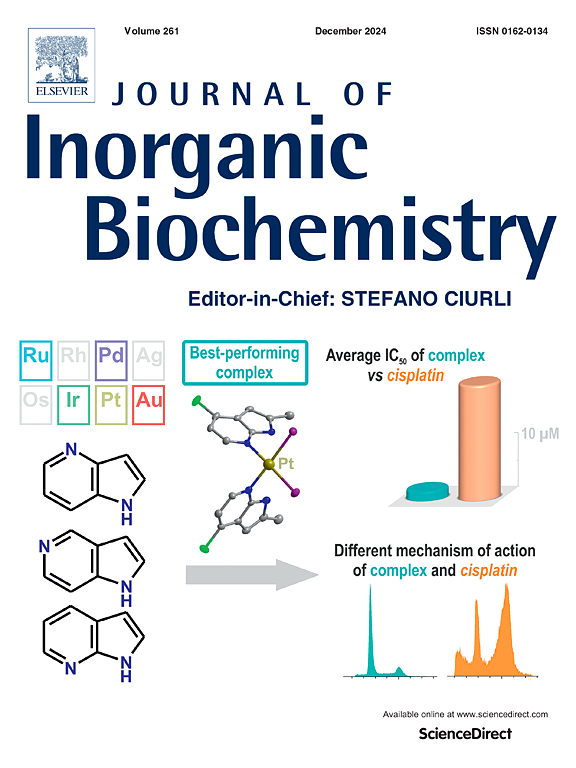亚硝酸盐与肌红蛋白和血红蛋白的结合:反应性和结构方面。
IF 3.8
2区 化学
Q2 BIOCHEMISTRY & MOLECULAR BIOLOGY
引用次数: 0
摘要
亚硝酸盐(NO2-)与肌红蛋白(Mb)和血红蛋白(Hb)相互作用,作为亚铁(即Mb(II)和Hb(II))和铁(即Mb(III)和Hb(III))形式的配体。然而,虽然与Fe(III)的结合对应于稳定络合物的形成(即Mb(III)-NO2-和Hb(III)-NO2-),但在亚铁形成的情况下,反应进行的是亚硝酸盐还原酶氧化还原过程,导致血红素蛋白氧化,NO2-还原为NO。这一事件对于体内血液和横纹肌中一氧化氮的快速生成至关重要,对血液流动的调节至关重要,因此对缺氧组织(如眼睛的视网膜)的氧气供应至关重要。此外,NO2-与Mb(II)- o2和Hb(II)- o2相互作用,以复杂的机制诱导其氧化,该机制仅部分阐明。Mb和Hb通过o -亚硝基结合模式(即Fe-ONO-)与NO2-形成配合物,该模式受铺铺血红素远端残基的调节;因此,在位点导向突变体中,HisE7被Val取代,相互作用以n -硝基结合模式(即Fe-N(O)O-)发生,就像大多数其他血红素蛋白一样。本文讨论了NO2-与铁态和亚铁态的Mb和Hb相互作用的结构-功能关系。本文章由计算机程序翻译,如有差异,请以英文原文为准。

Nitrite binding to myoglobin and hemoglobin: Reactivity and structural aspects
Nitrite (NO2−) interacts with myoglobin (Mb) and hemoglobin (Hb) behaving as a ligand of both the ferrous (i.e., Mb(II) and Hb(II)) and ferric (i.e., Mb(III) and Hb(III)) forms. However, while the binding to the Fe(III) species corresponds to the formation of a stable complex (i.e., Mb(III)-NO2− and Hb(III)-NO2−), in the case of the ferrous forms the reaction proceeds with a nitrite reductase redox process, leading to the oxidation of the heme-protein with the reduction of NO2− to NO. This event is of the utmost importance for the rapid production of NO in vivo in the blood stream and in striated muscles, being crucial for the regulation of the blood flow, and thus for O2 supply to poorly oxygenated tissues, such as the eye's retina. Further, NO2− interacts with Mb(II)-O2 and Hb(II)-O2, inducing their oxidation with a complex mechanism, which has been only partially elucidated. Mb and Hb form the complex with NO2− through the O-nitrito binding mode (i.e., Fe-ONO−), which is regulated by residues paving the heme distal side; thus, in a site-directed mutant, where HisE7 is substituted by Val, the interaction occurs in the N-nitro binding mode (i.e., Fe-N(O)O−), like in most other heme-proteins. The structure-function relationships of the interaction of NO2− with both ferric and ferrous forms of Mb and Hb are discussed here.
求助全文
通过发布文献求助,成功后即可免费获取论文全文。
去求助
来源期刊

Journal of Inorganic Biochemistry
生物-生化与分子生物学
CiteScore
7.00
自引率
10.30%
发文量
336
审稿时长
41 days
期刊介绍:
The Journal of Inorganic Biochemistry is an established international forum for research in all aspects of Biological Inorganic Chemistry. Original papers of a high scientific level are published in the form of Articles (full length papers), Short Communications, Focused Reviews and Bioinorganic Methods. Topics include: the chemistry, structure and function of metalloenzymes; the interaction of inorganic ions and molecules with proteins and nucleic acids; the synthesis and properties of coordination complexes of biological interest including both structural and functional model systems; the function of metal- containing systems in the regulation of gene expression; the role of metals in medicine; the application of spectroscopic methods to determine the structure of metallobiomolecules; the preparation and characterization of metal-based biomaterials; and related systems. The emphasis of the Journal is on the structure and mechanism of action of metallobiomolecules.
 求助内容:
求助内容: 应助结果提醒方式:
应助结果提醒方式:


